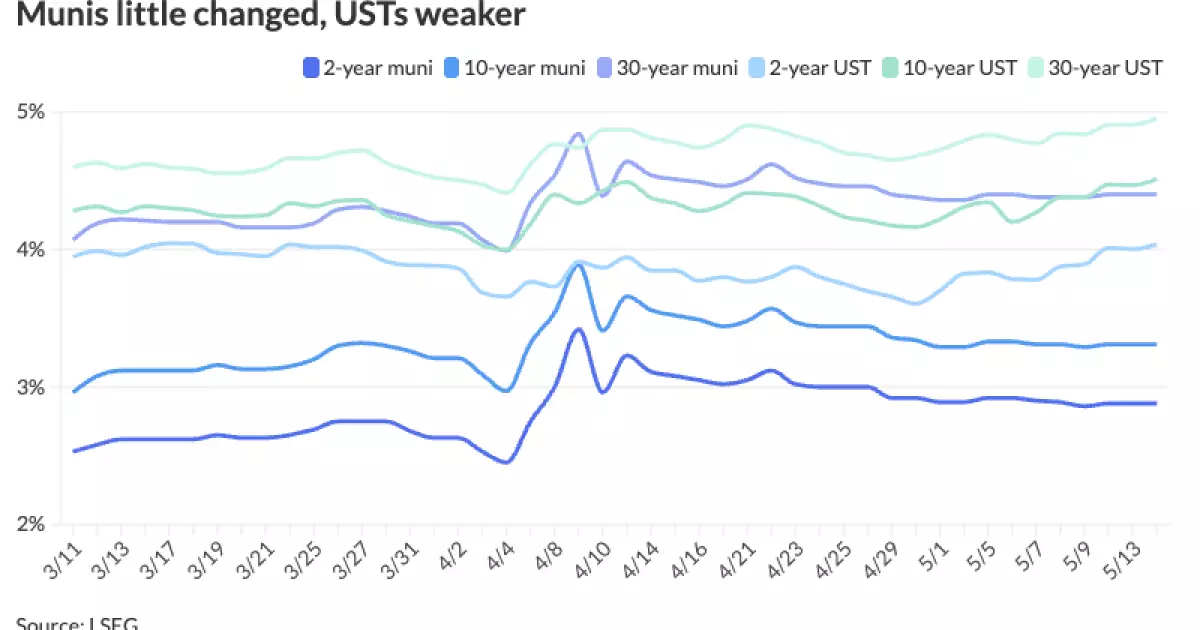In an era marked by political volatility and trade tensions, the municipal bond market has exhibited remarkable resilience, defying expectations set during the initial shock of President Trump’s tariff announcements. Jamie Doffermyre, the head of public finance syndicate and origination at Truist Securities, provided insight into this unexpected stability during his address at the Bond Buyer’s Southeast Public Finance Conference in Atlanta. His assertion that the municipal bond market has withstood recent turbulence reveals the tenacity of municipal securities, but it also underscores the fragility that lies beneath the surface.
Despite experiencing a modest uptick in yields—most notably, the five-year MMD yield moving from 2.81% to 2.96%—the underlying sentiment remains cautious. Such a minor rise might seem trivial to the casual observer, yet this 15 basis point increase, along with other market behaviors, reflects a deeper narrative about investor confidence amidst external pressures. The juxtaposition of municipal bonds’ performance relative to U.S. Treasury securities raises crucial questions about how long this optimism can hold.
Understanding Market Dynamics Through Beta
Doffermyre emphasized that municipal bonds operate with a 50% beta to rates, implying that while they may respond to interest rate fluctuations, they tend to exhibit stability even in tumultuous times. It is important, however, to recognize that this beta, while impressive, only masks the significant risks currently lurking in the market. As the bond yield spreads widen, examining the broader economic ramifications of such behavior requires a more nuanced perspective.
In the same vein, the 10-year MMD yield reflects similar trends, closing at 3.31%—growing from 3.21% in a matter of days—suggesting that while rebounds are present, we must interrogate their sustainability. Any complacency that arises from momentary gains could render investors vulnerable when faced with the next wave of news—particularly in a political landscape rife with unpredictability.
Sector Vulnerabilities: Healthcare and Education
The insights shared by Ronald Banaszek from Blaylock Van paint a concerning picture for certain sectors, notably healthcare and higher education, which may encounter unique challenges stemming from the tariff climate. While the overall credit environment may be deemed healthy, these particular areas remain on shaky ground. The potential for tariffs to erode credit quality in these sectors cannot be understated, leaving many investors fluttering on the edge of uncertainty.
The upcoming expiration of the 90-day tariff suspension poses existential questions. If the tariffs were to be reinstated, the ramifications might ripple through municipalities already grappling with tight budgets and fragile finances. Thus, the discourse around municipal bonds transforms from a narrative of resilience into one of cautious vigilance, where the implications of political decisions echo throughout multiple economic layers.
The Impending Reality of Credit Dislocation
Gary Hall’s comments regarding the potential for true credit dislocation elevate concerns from mere speculation to tangible worries. The market operates in a delicate balance, and indicators suggest that certain credits may soon experience significant stress, resulting in access challenges for municipalities. As the municipal bond market stands on the precipice, investors must prepare for the genuine possibility that stability could give way to pronounced risk.
This cautionary perspective must be weighed against the backdrop of opportunity—the municipal bond market can serve as both a safe haven and a battleground. While some argue that credit spreads are normalizing and investment-grade securities appear to be recovering, the landscape remains fraught with complexity. It is imperative to remain attuned to the signs of dislocation, as being ahead of the curve could be the difference between safeguarding investments and navigating adverse market conditions.
Thinking Beyond the Immediate Gains
As evidenced by Bryan Derdenger’s assessment of credit spread normalization post-tariff volatility, market participants often oscillate between optimism and fear. While it is tempting to bask in temporary recoveries, prudent investors must seek a deeper understanding of the forces that could thwart such progress. The recent tariff truce may instill a sense of hope, but the reality remains that complacency could bring about detrimental consequences.
Embracing a center-right perspective on economic policy suggests that a government-stimulated environment—characterized by strategic tariffs designed to protect domestic markets—can yield benefits in the right contexts. However, the key lies in balance. Mistakes in policy that disregard broader economic signals could hinder investment returns and inhibit recovery phases. Thus, as investors shift focus back to the municipal bond market, they must tread carefully, weighing the interplay between governmental decisions, market sentiment, and long-term stability.

